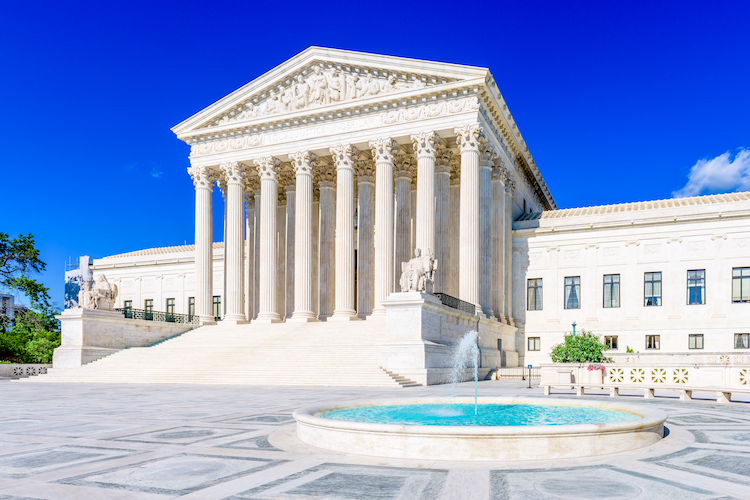SCOTUS Kicks Off January 2024 Session With Five Cases

The U.S. Supreme Court returned from recess on January 4, 2024. The Court’s January session will feature some of the Term’s biggest cases, with several testing the limit of the federal government’s regulatory power.
To kick off the session, the justices heard oral arguments in five cases. Below is a brief summary of the issues before the Court:
Federal Bureau of Investigation v. Fikre: The case revolves around the “No Fly List” established by the federal government in the wake of the September 11 attacks. Individuals are sometimes removed from the No Fly List during ongoing litigation about their placement on that list. The Fourth and Sixth Circuit Courts of Appeal have held that an individual’s removal from the No Fly List moots a case when the government represents that the individual will not be placed back on the list based on currently available information. However, the Ninth Circuit held that the respondent’s claims were not moot even though he was removed from the No Fly List in 2016 and the government provided a sworn declaration stating that he “will not be placed on the No Fly List in the future based on the currently available information.” The Supreme Court has agreed to address the circuit split and specifically answer the following question: “Whether respondent’s claims challenging his placement on the No Fly List are moot given that he was removed from the No Fly List in 2016 and the government provided a sworn declaration stating that he ‘will not be placed on the No Fly List in the future based on the currently available information.’”
Campos-Chaves v. Garland: The immigration case centers on the Immigration and Nationality Act, which provides that a noncitizen who does not appear at a removal hearing shall be ordered removed in absentia. but only if she was provided “written notice required under paragraph (l) or (2) of section 1229(a).” The Act authorizes rescission of an in absentia order if the noncitizen “did not receive notice in accordance with paragraph (1) or (2) of section 1229(a).” Paragraph (1) of section 1229(a) requires a single notice document that contains all the information specified in the statute, including the “time and place” of proceedings. Meanwhile, Paragraph (2) requires notice of the “new time and place” “in the case of any change or postponement in the time and place of such proceedings.” The justices have agreed to decide the following question: “Whether the government provides notice ‘required under’ and ‘in accordance with paragraph (1) or (2) of’8 U.S.C. § 1229(a)when it serves an initial notice document that does not include the ‘time and place’ of proceedings followed by an additional document containing that information, such that an immigration court must enter a removal order in absentia and deny a noncitizen’s request to rescind that order.
Office of the United States Trustee v. John Q. Hammons Fall 2006, LLC: Section 1004(a) of the Bankruptcy Judgeship Act of 2017 amended the schedule of quarterly fees payable to the United States Trustee in certain pending bankruptcy cases. In Siegel v. Fitzgerald, 142 S. Ct. 1770 (2022), the Supreme Court held that that the provision contravened Congress’s constitutional authority to “establish…uniform Laws on the subject of Bankruptcies,” U.S. Const. Art. I, § 8, Cl. 4, because it was initially applied only in the 88 federal judicial districts that have United States Trustees but not in the 6 districts that have Bankruptcy Administrators. The question now before the Court is: “Whether the appropriate remedy for the constitutional uniformity violation found by this court in Fitzgerald is to require the United States Trustee to grant retrospective refunds of the increased fees paid by debtors in U.S. Trustee districts during the period of disuniformity, or is instead either to deem sufficient the prospective remedy adopted by Congress or to require the collection of additional fees from a much smaller number of debtors in Bankruptcy Administrator districts.”
Sheetz v. County of El Dorado, California: Petitioner George Sheetz applied, to the County of El Dorado, California, for a permit to build a manufactured house on his property. Pursuant to legislation enacted by the County, and as the condition of obtaining the permit, Sheetz was required to pay a monetary exaction of $23,420 to help finance unrelated road improvements. The County demanded payment without making an individualized determination that the exaction bore an “essential nexus” and “rough proportionality” to the purported impacts associated with his modest project as required in Nollan v. Cal. Coastal Comm’n, 483 U.S. 825, 837 (1987) and Dolan v. City of Tigard, 512 U.S. 37 4, 391 (1994). The justices have agreed to consider whether a building-permit exaction is exempt from the unconstitutional-conditions doctrine as applied in Nollan v. California Coastal Commission and Dolan v. City of Tigard, Oregon simply because it is authorized by legislation.
Smith v. Arizona: The Sixth Amendment case centers on whether the Confrontation Clause allows the prosecution in a criminal trial to present testimony by a substitute expert conveying the testimonial statements of a non-testifying forensic analyst. The specific issue before the justices is: “Whether the confrontation clause of the Sixth Amendment permits the prosecution in a criminal trial to present testimony by a substitute expert conveying the testimonial statements of a non-testifying forensic analyst, on the grounds that (a) the testifying expert offers some independent opinion and the analyst’s statements are offered not for their truth but to explain the expert’s opinion, and (b) the defendant did not independently seek to subpoena the analyst.”
Decisions in all of the above cases are expected before the Term ends in June. Please check back for updates.
Previous Articles
SCOTUS Holds Wire Fraud Statute Doesn’t Require Proof Victim Suffered Economic Loss
by DONALD SCARINCI on June 24, 2025
In Kousisis v. United States, 605 U.S. ____ (2025), the U.S. Supreme Court held that a defendant wh...
SCOTUS Holds Wire Fraud Statute Doesn’t Require Proof Victim Suffered Economic Loss
by DONALD SCARINCI on June 17, 2025
In Kousisis v. United States, 605 U.S. ____ (2025), the U.S. Supreme Court held that a defendant wh...
SCOTUS Considers Birthright Citizenship
by DONALD SCARINCI on June 13, 2025
On May 15, 2025, the U.S. Supreme Court heard oral arguments in Trump v. CASA, Inc., Trump v. Washi...
The Amendments
-
Amendment1
- Establishment ClauseFree Exercise Clause
- Freedom of Speech
- Freedoms of Press
- Freedom of Assembly, and Petitition
-
Amendment2
- The Right to Bear Arms
-
Amendment4
- Unreasonable Searches and Seizures
-
Amendment5
- Due Process
- Eminent Domain
- Rights of Criminal Defendants
Preamble to the Bill of Rights
Congress of the United States begun and held at the City of New-York, on Wednesday the fourth of March, one thousand seven hundred and eighty nine.
THE Conventions of a number of the States, having at the time of their adopting the Constitution, expressed a desire, in order to prevent misconstruction or abuse of its powers, that further declaratory and restrictive clauses should be added: And as extending the ground of public confidence in the Government, will best ensure the beneficent ends of its institution.





